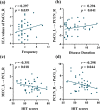Impaired effective functional connectivity of the sensorimotor network in interictal episodic migraineurs without aura
- PMID: 32928098
- PMCID: PMC7489040
- DOI: 10.1186/s10194-020-01176-5
Impaired effective functional connectivity of the sensorimotor network in interictal episodic migraineurs without aura
Abstract
Background: Resting-state functional magnetic resonance imaging (Rs-fMRI) has confirmed sensorimotor network (SMN) dysfunction in migraine without aura (MwoA). However, the underlying mechanisms of SMN effective functional connectivity in MwoA remain unclear. We aimed to explore the association between clinical characteristics and effective functional connectivity in SMN, in interictal patients who have MwoA.
Methods: We used Rs-fMRI to acquire imaging data in 40 episodic patients with MwoA in the interictal phase and 34 healthy controls (HCs). Independent component analysis was used to profile the distribution of SMN and calculate the different SMN activity between the two groups. Subsequently, Granger causality analysis was used to analyze the effective functional connectivity between the SMN and other brain regions.
Results: Compared to the HCs, MwoA patients showed higher activity in the bilateral postcentral gyri (PoCG), but lower activity in the left midcingulate cortex (MCC). Moreover, MwoA patients showed decreased effective functional connectivity from the SMN to left middle temporal gyrus, right putamen, left insula and bilateral precuneus, but increased effective functional connectivity to the right paracentral lobule. There was also significant effective functional connectivity from the primary visual cortex, right cuneus and right putamen to the SMN. In the interictal period, there was positive correlation between the activity of the right PoCG and the frequency of headache. The disease duration was positively correlated with abnormal effective functional connectivity from the left PoCG to right precuneus. In addition, the headache impact scores were negatively correlated with abnormal effective functional connectivity from the left MCC to right paracentral lobule, as well as from the right precuneus to left PoCG.
Conclusions: These differential, resting-state functional activities of the SMN in episodic MwoA may contribute to the understanding of migraine-related intra- and internetwork imbalances associated with nociceptive regulation and chronification.
Keywords: Effective functional connectivity; Magnetic resonance imaging; Migraine; Sensorimotor network.
Conflict of interest statement
The authors declare that they have no competing interests.
Figures



Similar articles
-
Aberrant activity within auditory network is associated with psychiatric comorbidities in interictal migraineurs without aura.Brain Imaging Behav. 2021 Oct;15(5):2464-2471. doi: 10.1007/s11682-020-00446-9. Epub 2021 Jan 21. Brain Imaging Behav. 2021. PMID: 33479923
-
Abnormal Functional Network Centrality and Causal Connectivity in Migraine Without Aura: A Resting-State fMRI Study.Brain Behav. 2025 Mar;15(3):e70414. doi: 10.1002/brb3.70414. Brain Behav. 2025. PMID: 40079637 Free PMC article.
-
Altered functional connectivity of the red nucleus and substantia nigra in migraine without aura.J Headache Pain. 2019 Nov 11;20(1):104. doi: 10.1186/s10194-019-1058-0. J Headache Pain. 2019. PMID: 31711434 Free PMC article.
-
The altered functional status in vestibular migraine: A meta-analysis.Brain Behav. 2024 Jun;14(6):e3591. doi: 10.1002/brb3.3591. Brain Behav. 2024. PMID: 38849984 Free PMC article. Review.
-
Resting State Electrophysiological Cortical Activity: A Brain Signature Candidate for Patients with Migraine.Curr Pain Headache Rep. 2022 Apr;26(4):289-297. doi: 10.1007/s11916-022-01030-0. Epub 2022 Feb 19. Curr Pain Headache Rep. 2022. PMID: 35182303 Review.
Cited by
-
Pain-Related Brain Connectivity Changes in Migraine: A Narrative Review and Proof of Concept about Possible Novel Treatments Interference.Brain Sci. 2021 Feb 13;11(2):234. doi: 10.3390/brainsci11020234. Brain Sci. 2021. PMID: 33668449 Free PMC article. Review.
-
Altered static functional network connectivity predicts the efficacy of non-steroidal anti-inflammatory drugs in migraineurs without aura.Front Mol Neurosci. 2022 Sep 13;15:956797. doi: 10.3389/fnmol.2022.956797. eCollection 2022. Front Mol Neurosci. 2022. PMID: 36176962 Free PMC article.
-
Disrupted Functional Connectivity of the Amygdala Predicts the Efficacy of Non-steroidal Anti-inflammatory Drugs in Migraineurs Without Aura.Front Mol Neurosci. 2022 Feb 24;15:819507. doi: 10.3389/fnmol.2022.819507. eCollection 2022. Front Mol Neurosci. 2022. PMID: 35283727 Free PMC article.
-
A study on alterations in functional activity in migraineurs during the interictal period.Heliyon. 2022 Dec 16;9(1):e12372. doi: 10.1016/j.heliyon.2022.e12372. eCollection 2023 Jan. Heliyon. 2022. PMID: 36691529 Free PMC article.
-
Altered functional brain network patterns in patients with migraine without aura after transcutaneous auricular vagus nerve stimulation.Sci Rep. 2023 Jun 13;13(1):9604. doi: 10.1038/s41598-023-36437-1. Sci Rep. 2023. PMID: 37311825 Free PMC article.
References
-
- GBD 2017 DALYs and HALE Collaborators Global, regional, and national disability-adjusted life-years (DALYs) for 359 diseases and injuries and healthy life expectancy (HALE) for 195 countries and territories, 1990–2017: a systematic analysis for the global burden of disease study 2017. Lancet. 2018;392(10159):1859–1922. - PMC - PubMed
MeSH terms
LinkOut - more resources
Full Text Sources
Medical
Miscellaneous

